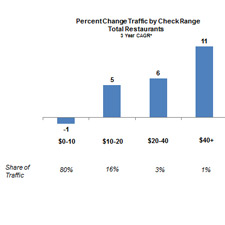The gap between high- and low-income groups is the widest it has been in 100 years, and the share of U.S. consumers who identify with the middle class has never been lower. Like other retail sectors, the restaurant industry is feeling the effects of this cultural and economic phenomenon, reports The NPD Group. One of the effects of income bifurcation is that visits to quick service restaurants, which have an average check size of about $5, were flat in the year ending June 2014 compared to same period last year, and visits to fine dining restaurants, which have an average check size of $40, were up 3 percent. Total restaurant industry traffic was flat for the period.

|
The challenge is that about 80 percent of restaurant visits are at quick service restaurants and the growth in fine dining visits, which holds only a single-digit traffic share, isn’t enough to increase overall traffic, according to NPD’s CREST® foodservice market research. Low-income consumers, who are heavier users of quick service restaurants, were most adversely affected by the Great Recession and have less discretionary income to spend on dining out. With low-income visit cutbacks and not enough fine dining traffic to make-up for traffic declines, restaurant operators will need to appeal to the middle-class to fill the gap, says NPD.
“Although the percentage of consumers identifying themselves with the middle class is shrinking, this group still represents a large segment of the population and shouldn’t be ignored,” says Bonnie Riggs, NPD’s restaurant industry analyst.
“However, offering a good product at a fair price is no longer good enough. To attract them will take a deeper understanding of what they want when dining out,” says Riggs. “Consumer attitudes and behaviors have changed since the Great Recession began and may well have changed for good. But the fact remains that Americans still make billions of visits to restaurants each year, but they are more conscious of their spending and want to be certain that the return on their investment in a restaurant meal is a pleasurable dining experience that meets their needs and expectations.”
